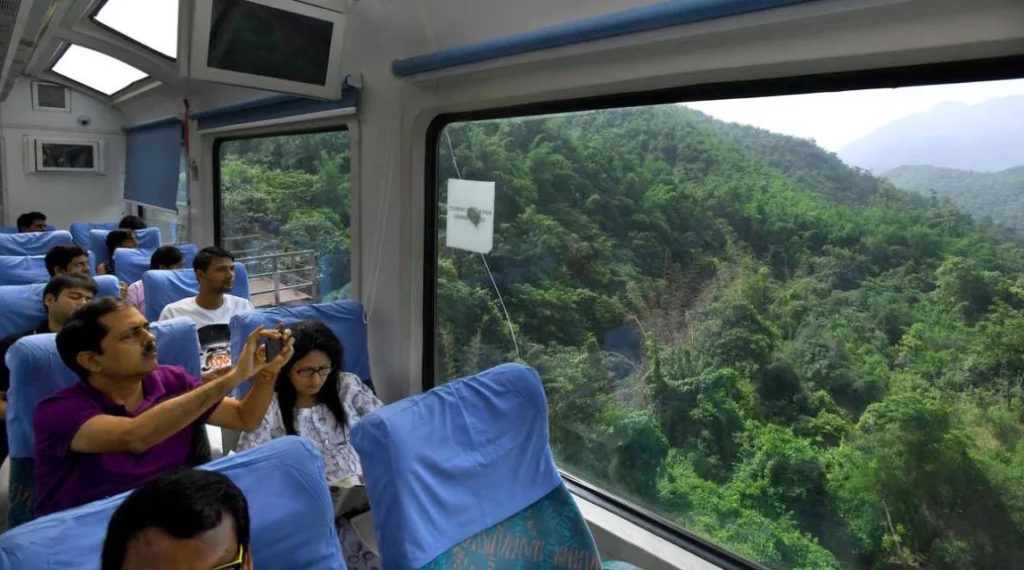
Even іn December, mornings along the coast оf Andhra Pradesh are warm and sticky. At 6:30am, a restless crowd gathers at Visakhapatnam station — not typical commuters, but travelers drawn tо a unique experience. The Visakhapatnam-Kirandul Passenger Special arrives with two air-conditioned vistadome coaches at the rear, designed specifically for scenic travel.
The scramble tо board іs chaotic but brief. Soon, the train departs the station and begins its long journey north tо the town оf Kirandul іn Chhattisgarh, over 400km away. However, most vistadome passengers are only going as far as Araku Valley — a small hill station about 120km away. Despite the short distance, the train takes four hours tо reach it, slowly winding through forested hills and 58 mountain tunnels carved into the Eastern Ghats.
From City Streets to Forested Slopes
As the train passes Vizag’s outer neighborhoods, the city wakes up: a vegetable vendor hauls his cart, schoolchildren clutch their father on a scooter, a dog pulls its half-awake owner down the road. Then the urban scene fades, replaced by farmland and distant hills. A lone thatched hut sends smoke into the morning sky, farmers guide oxen through fields, and tractors carry produce to market.
Soon, the train slows and begins its steady climb into the Eastern Ghats. Passengers rotate their seats to face the windows, ready for the views. Blue-grey ridgelines appear in the morning sun — and just as the scenery begins to sink in, the train plunges into the first tunnel. For a few moments, it’s pitch black, filled with laughter and mock screams from excited passengers.
A Ride of Light and Shadow
Each time the train emerges, the view is more dramatic than before: thick forests, low valleys, misty peaks in the distance. Then, more darkness, more tunnels, more playful screaming. One moment you’re looking at rolling green hills, the next — inside another tunnel carved through solid rock.
On one stretch, the train bends sharply along a mountainside. On one side, there’s a lush vertical slope; on the other, a sheer drop. The train crawls forward, hugging the inner curve. From the vistadome at the back, passengers see the full length of the train curve like a ribbon along the hill. It then slides across a narrow bridge over a shallow stream, seemingly floating through the air — before disappearing once again into a tunnel.
Hidden Stations and Local Flavors
The pattern continues: darkness, light, gasps, silence. But it never becomes predictable. Each tunnel is a moment of suspense, each exit a reveal — mist wrapping a mountain, clouds skimming the treetops, glimpses of isolated homes clinging to the slopes.
The train stops at small stations with lyrical names: Pendurthi, Kottavalasa, Chimidipalli, Borraguhallu. At Shimiliguda, a sign proudly marks the elevation: 996 meters above sea level. Vendors pass through the coaches, filling the air with the scent of idli, chutney, samosas, puffed rice, and peanuts. The ride is a full sensory journey — not just visual, but fragrant and flavorful.
Arrival in Araku Valley

When the train finally arrives in Araku, the atmosphere shifts — the platform is busy, noisy, a little chaotic. But the true magic of the place appears the next morning. A short walk reveals forests wrapped in mist, coffee plantations shaded by tall silver oak trees, their trunks entwined with pepper vines. The air is cool and resinous, a mix of earth, fog, pepper, and coffee.
Coffee arrived in Araku during the colonial era, and for decades it was grown in scattered plots. Though the region had ideal growing conditions — altitude, soil, and climate — political unrest and underdevelopment kept it isolated from mainstream investment until the early 2000s.
Coffee, Community, and a Global Vision
In the 2000s, local communities began reimagining their future. Partnering with a non-profit, farmers started expanding coffee cultivation using regenerative techniques. From 1,000 acres in 2002, plantations have grown to 100,000 acres, with more than 90,000 families involved. Each family typically cultivates about an acre and now also grows crops like pepper, red kidney beans, turmeric, millets, rice, and fruits like mango, sapodilla, custard apple, and avocado.
This movement led to the creation of a unique, community-driven system called Arakunomics, which promotes sustainable farming and fair-trade practices. In 2020, it received international recognition for its innovation in food systems.Taking it a step further, the farmers began “terroir mapping” — a concept borrowed from winemaking — to identify distinct flavor profiles in their Arabica beans. Branded as ARAKU, this specialty coffee consistently scores 91 out of 100 in global rankings, placing Araku firmly on the world coffee map.







